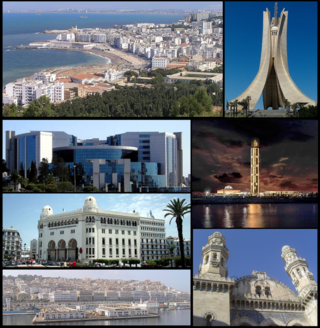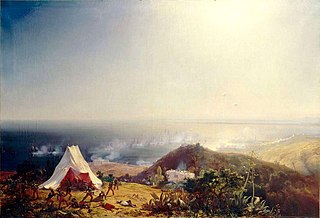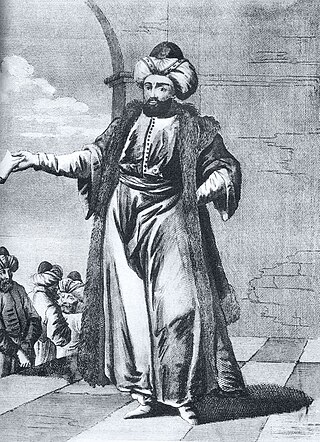
Algiers is the administrative, political and economic capital and largest city of Algeria as well as the capital of the Algiers Province. The city's population at the 2008 census was 2,988,145 and in 2020 was estimated to be around 4,500,000. located in the north-central part of the country, it extends along the shores of the Bay of Algiers in the heart of the Maghreb region making it classified among the biggest cities in North Africa, the Arab world and the Mediterranean Sea, making it a major center of culture, arts, gastronomy and trade.

Dey, from the Turkish honorific title dayı, literally meaning uncle, was the title given to the rulers of the Regency of Algiers (Algeria), Tripoli, and Tunis under the Ottoman Empire from 1671 onwards. Twenty-nine deys held office from the establishment of the deylicate in Algeria until the French conquest in 1830.

The Regency of Algiers was a largely independent early modern Ottoman tributary state on the Barbary Coast of North Africa between 1516 and 1830. Founded by the privateer brothers Aruj and Hayreddin Barbarossa, also known as Oruç and Khayr ad-Din, the Regency began as an infamous and formidable pirate base that plundered and waged maritime holy war on European Christian powers. Ottoman regents ruled as heads of a stratocracy; an autonomous military government controlled by the janissary corps, themed Garp ocaklarılit. 'Western Garrison' in Ottoman terminology.

Hussein Dey was the last Dey of the Deylik of Algiers.

The invasion of Algiers in 1830 was a large-scale military operation by which the Kingdom of France, ruled by Charles X, invaded and conquered the Deylik of Algiers.

The French conquest of Algeria took place between 1830 and 1903. In 1827, an argument between Hussein Dey, the ruler of the Regency of Algiers, and the French consul escalated into a blockade, following which the July Monarchy of France invaded and quickly seized Algiers in 1830, and seized other coastal communities. Amid internal political strife in France, decisions were repeatedly taken to retain control of the territory, and additional military forces were brought in over the following years to quell resistance in the interior of the country.

The Revolutions of Tunis or the Muradid War of Succession was a period of troubles and civil wars in Ottoman Tunisia. It ran from the death of the Muradid sovereign Murad II Bey in 1675 until the seizure of power by the Husainid sovereign Al-Husayn I ibn Ali at-Turki in 1705. The belligerents were Ali Bey al-Muradi and Muhammad Bey al-Muradi, their uncle Muhammad al-Hafsi al-Muradi, several Deys of Tunis, the Turkish militia in Tunis and the Dey of Algiers.
Ibrahim Sharif was Bey of Tunis from 1702 to 1705, during the revolutions of Tunis, a period of crisis which brought an end to the Muradid dynasty and preceded the rise to power of Husayn I Bey.

Battle of Staoueli, was a battle between the Kingdom of France and the Regency of Algiers in western Algiers while France was trying to take control over the capital.
The Shipwreck of Dellys took place in May 1830, during the French conquest of Algeria. It involved French troupes coloniales, under captains Félix-Ariel d'Assigny (1794-1846) and Armand Joseph Bruat (1796-1855), who were captured by the resistance fighters of the town of Dellys in Kabylia of the Igawawen.
Mohamed ben Hassan or Muhammad III was the 12th ruler and Dey of Algiers. He ruled five months after his predecessor Baba Ali Chaouch.
The Maghrebi war (1699–1702) was a conflict involving a Tunisian, Tripolitanian, and Moroccan coalition, and the Deylik of Algiers. It was an important milestone in the further weakening of the already fragile Ottoman grip over the Maghreb, as both sides utterly ignored the Ottoman sultan's pleas to sign a peace treaty. This war also led to the renewal of the Muradid infighting, which would later lead to the establishment of the Beylik of Tunis, and the Husainid dynasty in 1705.
The Constantine campaign was launched by Bey of Tunis Murad III Bey in 1699 to capture the Beylik of Constantine, situated in the east of the Deylik of Algiers.
The Battle of Jouami' al-Ulama took place on 3 October 1700 near Sétif, Algeria. It was fought between the armies of the Bey of Tunis Murad III and those of the Deylik of Algiers commanded by the Dey Hadj Mustapha, and a newly elected Bey of Constantine, Ahmed ben Ferhat.

The Tunisian–Algerian War of 1807 was a conflict between the Beylik of Tunis and the Deylik of Algiers. The war led to the emancipation of Tunisia from any sort of Algerian influence, and the ending of the tribute paid by Tunisia to Algeria since 1756.
The Tunisian–Algerian War of 1705 was a conflict between the Regency of Algiers and the Regency of Tunis.
Hadj Mustapha was the 7th ruler and Dey of Algiers. He ruled five years after his predecessor Hadj Chaouch.
The Siege of Tunis (1705) was a battle between the Regency of Algiers and the Regency of Tunis.

Sidi Hassan, also known as Hassan Pacha or Hassan III Pacha was the 17th ruler and Dey of Algiers. He ruled for 11 years after his predecessor Baba Mohammed ben-Osman.








